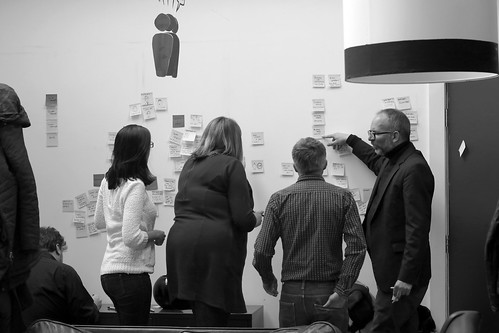Podcast: Play in new window | Download
Subscribe: iTunes | Android | RSS

Today’s interview is with Birgit Mager who is the Professor for Service Design at KISD, the Köln International School of Design, based in Cologne, Germany and the president of the International Service Design Network (SDN). Birgit joins me today to talk about service design, design thinking, why it’s becoming more and more popular and how it can be used to produce better outcomes for organisations, customers and employees.
This interview follows on from my recent interview – The benefits of surveying your customers at the point of experience – Interview with Lee Evans of SurveyMe – and is number 191 in the series of interviews with authors and business leaders that are doing great things, helping businesses innovate and delivering great service and experience to their customers.
Here’s the highlights of my interview with Birgit:
- Design has evolved over centuries from being the the bridge between industrial products and craftsmanship and how people use things to nowadays where a large part of it’s focus is on the digital interface between users and companies.
- However, more recently design has started to look at the more holistic experience that users go through when interacting with a company.
- Design as a special approach brings together a lot of user based research and a lot of co-created solutions where employees, customers and designers come together to better understand what the experience currently is, where the problems are, how they can be re-framed and what new and creative approaches exist.
- Design by its nature is very visual and allows groups to visualise complex systems, create shared understanding between stakeholders and, also, envision future scenarios through the building of things like mock-ups and prototypes.
- Service design and design thinking are different.
- Design thinking is a movement that is trying to make managers understand that design can contribute valuable processes, methods and tools for innovation.
- But, design thinking has become a bit of a ‘design-lite’ approach and many managers fall into the trap that after a 2-day course on design thinking that they have become ‘design thinkers’. That is a huge misunderstanding.
- Service design is different in that it goes much deeper into the system to help re-design strategies, structures, cultures and the interfaces between organisations and their employees and users.
- There has been a rise in the interest of design thinking and service design in the last few years with many of the large consultancies and other large companies acquiring service design agencies.
- Einstein: “We cannot solve the big problems that we are facing today with the same thinking that has created them”.
- There is a paradigm shift happening in management and corporate strategy where many leaders realise that they have to change the mode of thinking if they are to compete and differentiate themselves.
- Design seems to offer this type of change by not being an approach that helps make good decisions but by being an approach that helps develop great alternatives.
- Birgit provides two examples of service design projects in action:
- The first was a project that she undertook with her students in Cologne where the challenge was to create innovative service offerings for homeless people. To do that, they first conducted in-depth research with homeless people and stakeholders and then co-created a ‘survivors station for the homeless’ together with homeless people and social workers. What it doesn’t do is to try and change the life of the homeless person by bringing them back into work or accommodation but, rather, focuses on helping them have a dignified life during that transition phase of homelessness and, so, offers hygiene, a mailbox, a place to sleep and an internet enabled computer. This was implemented and has been running successfully since 2001.
- The second comes from Hellon, a service design agency in Helsinki, that worked with hospitals, GPs and women that had to go through a cancer diagnosis process. Normally, women would have to wait around 3 months from initial consultation til they received their test results to find out whether they had cancer or not. Following a similar approach to the project above, they were able to reduce the waiting time from initial consultation to results by 90%.
- If you don’t succeed in making a benefit for everyone in the system then the implementation of the concept will just not work.
- In the next couple of years, service design as an approach faces a few challenges:
- Measuring the impact of service design – if service design is to bridge the gap between taking a creative approach and traditional business then service designers need to prove the impact (qualitatively and quantitively) and the RoI of their approach as well as doing so in language of traditional business.
- A stronger voice in the boardroom and on a strategic level – this is linked to growing and improving service design education around the world but also means that service design needs to become more specific in its content i.e. the RCA in London is now running a course: Service Design for Policymakers.
- Growing a strong network – the Service Design Network aims to help service designers network, share and learn from the best cases so that it makes it easier for service designers to explain how and convince potential clients that service design could be good for them.
- Birgit’s top tips to those wanting to start exploring how service design could help them in their businesses would be:
- Visit any of the global or national conferences that the Service Design Network organises or any of their local networking events.
- Connect with other companies have utilised and experienced service design in their business so that they can get the right advice on how to choose the right service design agency, what it will cost, what resources are required and what to expect.
- The wow of today is the expectation of tomorrow.
- With respect to creating a Wow service/experience, Birgit believes that companies should be asking themselves whether they want to wow their customers or is it enough to fulfil customer expectations in a solid and caring way.
- Companies need to think about the emotion that they raise in the user experience and then they need to think about how they then manage that emotion with care.
- The cream on the pie does not rescue it if the pie itself is a pain.
- Please check out and join the Service Design Network and the community that is bringing design to services and is improving the quality of our lives, check out their global conference in Amsterdam on the 27th and 28th October and, finally, go and meet your local chapter.
About Birgit
 Since 1995, Birgit Mager has been the Professor for Service Design at KISD, the Köln International School of Design, based in Cologne, Germany.
Since 1995, Birgit Mager has been the Professor for Service Design at KISD, the Köln International School of Design, based in Cologne, Germany.
Over the past twenty years, she has been a leading figure in developing the theory and practice of service design. Her publications and lectures have contributed to the establishment of service design as an independent research discipline. Birgit Mager is the president of the International Service Design Network (SDN) and is responsible for organizing SDN‘s national and international conferences, such as this year’s conference in Amsterdam.
You can connect with Birgit on LinkedIn here and say Hi to her on Twitter @BiSDN.
Photo Credit: LisaJJeffery Flickr via Compfight cc



